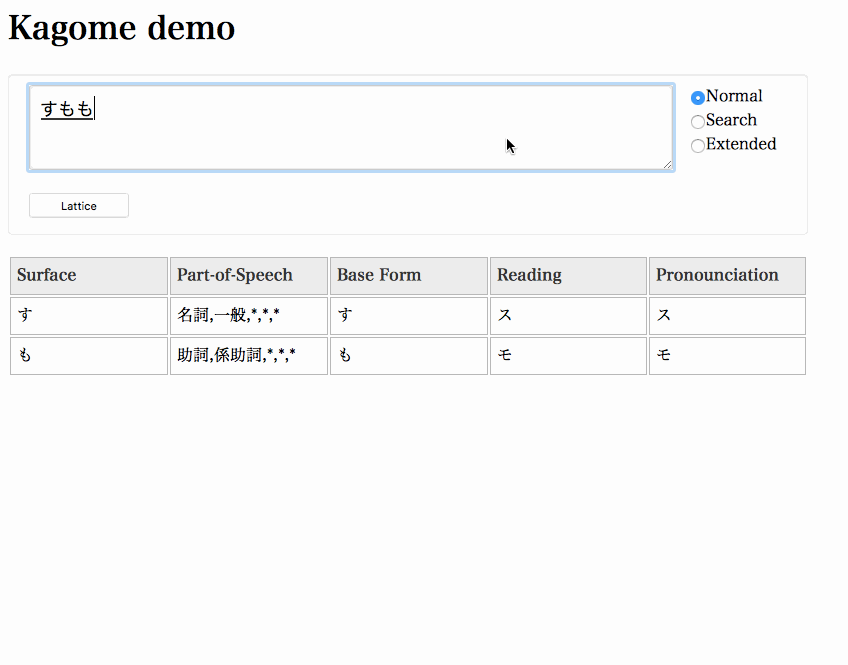Kagome is an open source Japanese morphological analyzer written in pure golang. The dictionary/statistical models such as MeCab-IPADIC, UniDic (unidic-mecab) and so on, are able to be embedded in binaries.
Improvements from v1.
- Dictionaries are maintained in a separate repository, and only the dictionaries you need are embedded in the binary.
- Brushed up and added several APIs.
| dict | source | package |
|---|---|---|
| MeCab IPADIC | mecab-ipadic-2.7.0-20070801 | github.com/ikawaha/kagome-dict/ipa |
| UniDIC | unidic-mecab-2.1.2_src | github.com/ikawaha/kagome-dict/uni |
Experimental Features
| dict | source | package |
|---|---|---|
| mecab-ipadic-NEologd | mecab-ipadic-neologd | github.com/ikawaha/kagome-ipa-neologd |
| Korean MeCab | mecab-ko-dic-2.1.1-20180720 | github.com/ikawaha/kagome-dict-ko |
Kagome has segmentation mode for search such as Kuromoji.
- Normal: Regular segmentation
- Search: Use a heuristic to do additional segmentation useful for search
- Extended: Similar to search mode, but also uni-gram unknown words
| Untokenized | Normal | Search | Extended |
|---|---|---|---|
| 関西国際空港 | 関西国際空港 | 関西 国際 空港 | 関西 国際 空港 |
| 日本経済新聞 | 日本経済新聞 | 日本 経済 新聞 | 日本 経済 新聞 |
| シニアソフトウェアエンジニア | シニアソフトウェアエンジニア | シニア ソフトウェア エンジニア | シニア ソフトウェア エンジニア |
| デジカメを買った | デジカメ を 買っ た | デジカメ を 買っ た | デ ジ カ メ を 買っ た |
package main
import (
"fmt"
"strings"
"github.com/ikawaha/kagome-dict/ipa"
"github.com/ikawaha/kagome/v2/tokenizer"
)
func main() {
t, err := tokenizer.New(ipa.Dict(), tokenizer.OmitBosEos())
if err != nil {
panic(err)
}
// wakati
fmt.Println("---wakati---")
seg := t.Wakati("すもももももももものうち")
fmt.Println(seg)
// tokenize
fmt.Println("---tokenize---")
tokens := t.Tokenize("すもももももももものうち")
for _, token := range tokens {
features := strings.Join(token.Features(), ",")
fmt.Printf("%s\t%v\n", token.Surface, features)
}
}output:
---wakati---
[すもも も もも も もも の うち]
---tokenize---
すもも 名詞,一般,*,*,*,*,すもも,スモモ,スモモ
も 助詞,係助詞,*,*,*,*,も,モ,モ
もも 名詞,一般,*,*,*,*,もも,モモ,モモ
も 助詞,係助詞,*,*,*,*,も,モ,モ
もも 名詞,一般,*,*,*,*,もも,モモ,モモ
の 助詞,連体化,*,*,*,*,の,ノ,ノ
うち 名詞,非自立,副詞可能,*,*,*,うち,ウチ,ウチGo
go install github.com/ikawaha/kagome/v2@latestHomebrew tap
brew install ikawaha/kagome/kagome$ kagome -h
Japanese Morphological Analyzer -- github.com/ikawaha/kagome/v2
usage: kagome <command>
The commands are:
[tokenize] - command line tokenize (*default)
server - run tokenize server
lattice - lattice viewer
sentence - tiny sentence splitter
version - show version
tokenize [-file input_file] [-dict dic_file] [-userdict userdic_file] [-sysdict (ipa|uni)] [-simple false] [-mode (normal|search|extended)] [-split] [-json]
-dict string
dict
-file string
input file
-json
outputs in JSON format
-mode string
tokenize mode (normal|search|extended) (default "normal")
-simple
display abbreviated dictionary contents
-split
use tiny sentence splitter
-sysdict string
system dict type (ipa|uni) (default "ipa")
-udict string
user dict% # interactive mode
% kagome
すもももももももものうち
すもも 名詞,一般,*,*,*,*,すもも,スモモ,スモモ
も 助詞,係助詞,*,*,*,*,も,モ,モ
もも 名詞,一般,*,*,*,*,もも,モモ,モモ
も 助詞,係助詞,*,*,*,*,も,モ,モ
もも 名詞,一般,*,*,*,*,もも,モモ,モモ
の 助詞,連体化,*,*,*,*,の,ノ,ノ
うち 名詞,非自立,副詞可能,*,*,*,うち,ウチ,ウチ
EOS% # piped standard input
echo "すもももももももものうち" | kagome
すもも 名詞,一般,*,*,*,*,すもも,スモモ,スモモ
も 助詞,係助詞,*,*,*,*,も,モ,モ
もも 名詞,一般,*,*,*,*,もも,モモ,モモ
も 助詞,係助詞,*,*,*,*,も,モ,モ
もも 名詞,一般,*,*,*,*,もも,モモ,モモ
の 助詞,連体化,*,*,*,*,の,ノ,ノ
うち 名詞,非自立,副詞可能,*,*,*,うち,ウチ,ウチ
EOS% # JSON output
% echo "猫" | kagome -json | jq .
[
{
"id": 286994,
"start": 0,
"end": 1,
"surface": "猫",
"class": "KNOWN",
"pos": [
"名詞",
"一般",
"*",
"*"
],
"base_form": "猫",
"reading": "ネコ",
"pronunciation": "ネコ",
"features": [
"名詞",
"一般",
"*",
"*",
"*",
"*",
"猫",
"ネコ",
"ネコ"
]
}
]echo "私ははにわよわわわんわん" | kagome -json | jq -r '.[].pronunciation'
ワタシ
ワ
ハニワ
ヨ
ワ
ワ
ワンワンAPI
Start a server and try to access the "/tokenize" endpoint.
% kagome server &
% curl -XPUT localhost:6060/tokenize -d'{"sentence":"すもももももももものうち", "mode":"normal"}' | jq .Web App
Start a server and access http://localhost:6060.
(To draw a lattice, demo application uses graphviz . You need graphviz installed.)
% kagome server &A debug tool of tokenize process outputs a lattice in graphviz dot format.
% kagome lattice 私は鰻 | dot -Tpng -o lattice.pngYou can see how kagome wasm works in demo site.
The source code can be found in ./sample/wasm.
MIT





